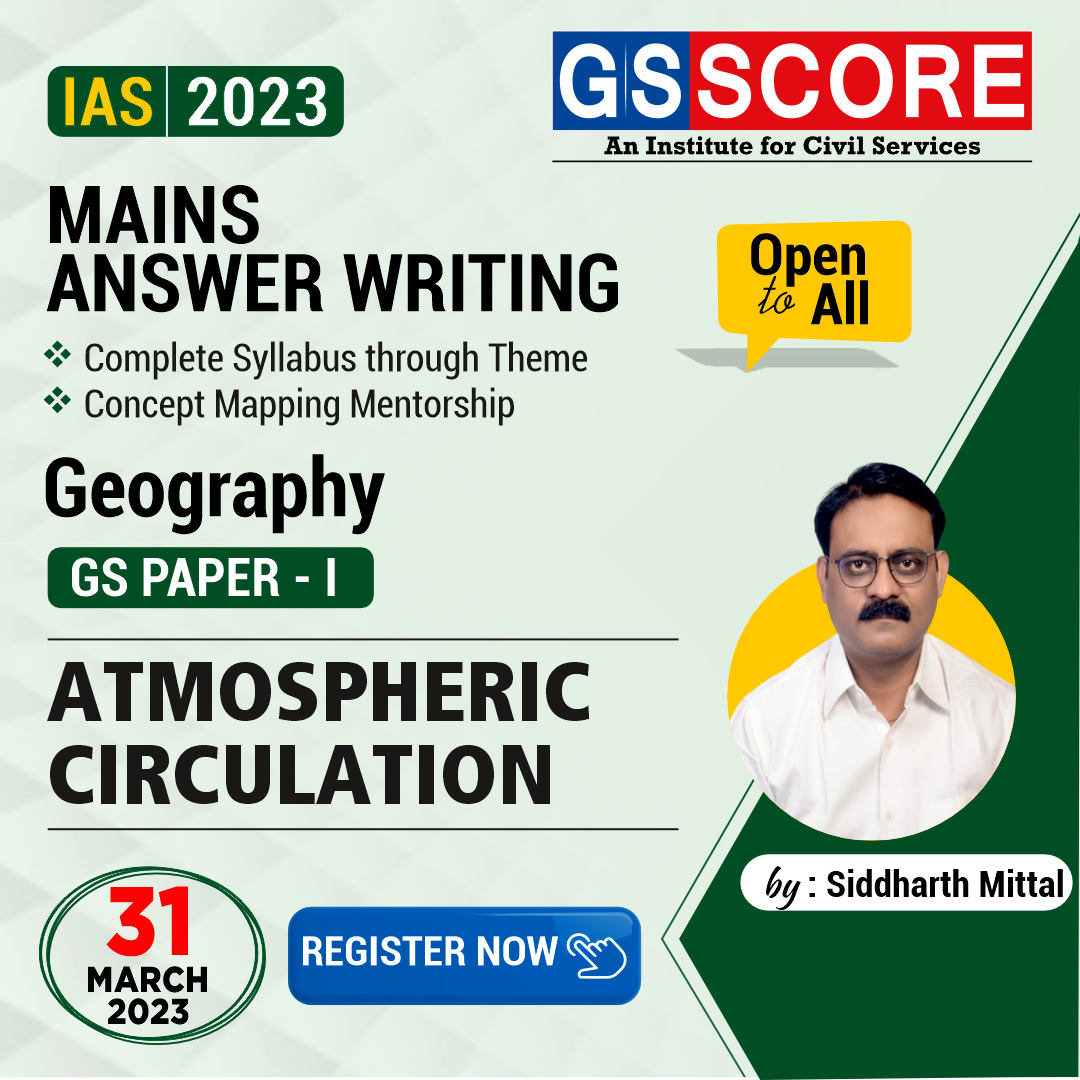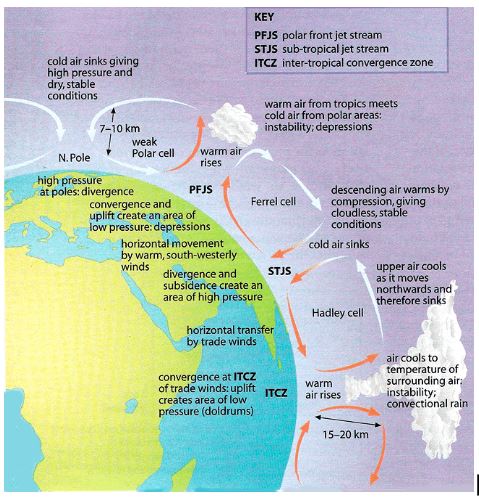


Instruction:
- There will be 2 questions carrying 10 marks each. Write your answers in 150 words
- Any page left blank in the answer-book must be crossed out clearly.
- Evaluated Copy will be re-uploaded on the same thread after 2 days of uploading the copy.
- Discussion of the question and one to one answer improvement session of evaluated copies will be conducted through Google Meet with concerned faculty. You will be informed via mail or SMS for the discussion.
Question #1. Apart from thermal gradient factors other factors such as relief, orography and upper air circulation are responsible for onset of monsoon in the Indian sub-continent. Elucidate.
Question #2. What is tri cellular meridional circulation of the atmosphere? Discuss the role of meridional circulation in the transfer of energy and in maintaining the heat budget of the earth.
(Examiner will pay special attention to the candidate's grasp of his/her material, its relevance to the subject chosen, and to hi/ her ability to think constructively and to present his/her ideas concisely, logically and effectively).
STEPS & INSTRUCTIONS for uploading the answers
Step 1 - The Question for the day is provided below these instructions. It will be available at 7:00 AM.
Step 2 - Uploading of Answers : Write the answer in A4 Sheet leaving proper margins for comments and feedback and upload the PDF in MY ACCOUNT section. Click on the option of SUBMIT COPY to upload the PDF.
Step 3 - Deadline for Uploading Answers: The students shall upload their answers by 7:00 PM in the evening same day. The first 50 copies will be evaluated.
Step 4 - Feedback : Mentors will give their feedback for the answers uploaded. For more personalised feedback, join our telegram channel by clicking on the link https://t.me/mains_answer_writing_cse . A one-to-one session will be conducted with the faculty after copy evaluation in 72 Hrs.
Model Answer
Question #1. Apart from thermal gradient factors other factors such as relief, orography and upper air circulation are responsible for onset of monsoon in the Indian sub-continent. Elucidate.
Approach:
- Briefly discuss the development in study and factors associated with monsoon. ( 40 words)
- Discuss different dynamic factors influencing monsoon apart from thermal contrast. ( 170 words)
- Conclude briefly with global phenomenon which impacts monsoon. ( 40 words)
Hints:
Initially, monsoon was thought to be the product of thermal contrasts between the land and ocean but gradually various other factors started to be associated with monsoon such as influence of relief, orography and upper air circulation. These factors together summed up and made it a dynamic phenomenon which is characterized by reversal of ocean currents and monsoon winds over the Indian Ocean.
Different dynamic factors influencing monsoon apart from thermal contrast
- Traditional concepts of monsoon were based on thermal contrast i.e differential heating of land and sea which caused creation of pressure gradients between the two.
- This led to flow of monsoon winds from center of high pressure to the center of low pressure which reversed during winter and summer called winter and summer monsoon respectively.
- However, later different factors were identified which lead to development and establishment of monsoon over the Indian sub-continent.
1. Intercontinental Convergence Zone and impact of air masses:
- It is meeting point of north-east and south-east trade wind which shifts north and south of the equator with change in season. It shifts northward when the sun shines at tropic of cancer and towards south when tropic of cancer shines at tropic of Capricorn.
- Due to shift of ITCZ towards north during summer in northern hemisphere, area around Tibetan plateau becomes a low pressure zone attracting the monsoon winds towards it. This monsoon wind is called south-west monsoon.
- Break in monsoon is also influenced by high pressure trough, which sometimes establishes above the Bay of Bengal.
Upper Air circulation and the Jet streams
- Burst of monsoon also depends upon the upper air circulation as due to shift in westerly Jet Stream towards north during summer, the low latitude upper air trough shifts from 90ºE to 80º E which attracts the monsoon towards Indian sub-continent.
- Apart from westerly jet stream, the monsoon is also impacted by the Easterly jet stream which blows 13 km above the ground over peninsular India.
- When westerly jet stream shifts northward during summer, easterly jet stream takes its course and establishes over southern Himalayas.
- Easterly get stream is formed due to heating of Tibetan plateau and rising hot air cools down in the upper atmosphere and starts to blow towards low pressure formed in the upper troposphere above Mascrene high pressure zone.
- Further, there has been considerable impact of Phinlander Jet stream or Somali jet stream on Indian monsoon.
Physiography:
- Physiography of Indian sub-continent plays an important role in rainfall pattern of the Indian sub-continent. It strikes almost perpendicular to the western side of the Western Ghats causing heavy rainfall.
- Similarly, funnel shaped Meghalayan plateau compels the monsoon wind to rise over it making it the wettest place on the planet. Similarly, parallel ranges of Aravallis do not obstruct the monsoon.
- Secondly, the monsoon rainfall is an Orographic rainfall. Hence, Himalayas and other mountain ranges including Western Ghats play an important role its establishment over Indian sub-continent.
Conclusion:
Apart from regional factors various global phenomenon such as El-Nino southern oscillation and Julian-Medellion Oscillation also impacts the Indian monsoon. Hence, it can be said that Indian monsoon is more than the product of thermal contrast as thought previously. Hence, it is a product of various factors such as orography, thermal contrast and upper air circulation including and impacted by global weather phenomenon such as El-Nino and La-Nina.
Question #2. What is tri cellular meridional circulation of the atmosphere? Discuss the role of meridional circulation in the transfer of energy and in maintaining the heat budget of the earth.
Approach:
- Introduction: Briefly define Tricellular meridional circulation and contextualise the question
- Describe characteristics of Tricellular meridional circulation
- Discuss the role of the circulation in transfer of energy
- Describe how it maintains the heat budget of the earth
- Conclude with importance of Tricellular meridional circulation
Hint:
The tricellular meridional circulation (TMC) divides the global air circulation into three cells based on thermal and dynamic factors associated with global air circulation. TMC is a useful model to explain Earth’s atmospheric phenomenon.
TMC Model: The 3 cells are as follows:
- Hadley cell: found between 10 degrees and 30 deg latitude
- Solar cell that is thermally induced by the high solar insolation received in the equatorial area
- Warm air rises at the equator creating a low pressure in the tropics and the ascending air cools and descends at the 30 degree latitude which causes a high pressure at the sub tropical regions
- The cell is then completed by the trade winds that flow from the high pressure to the low pressure equator
- Hadley cell is one of the most stable cells, and it's linked to a tropical monsoon and a desert climate.
- Ferrel Cell: 35 to 60 degree latitude
- Dynamically induced cell in which the sub-polar air warms up and rises and as it cools near the tropopause and then descends at the 35 degree latitude (horse latitudes) creating high pressure. Similarly warm air that rose at the equator also descends and cools down at the horse latitudes
- Westerly winds blowing polewards complete the ferrel cell
- Polar Cell: 65 to 90 degrees.
- Thermally direct cell that is at its most powerful in the winter.
- Easterly winds travel from poles to the subpolar low. The sinking air moves along the poles.
- The easterly and westerly winds collide at the subpolar lows, causing the air to rise and complete the polar cell circulation.
Figure: Tricellular Meridional Circulation: the 3 cells
Role of TMC in transfer of energy
- Earth is heated differentially by the Sun with lower latitudes being heated through direct perpendicular insolation and higher latitudes by indirect, slant insolation
- Tricellular meridional circulation ensures that energy is redistributed across the globe by means of winds and Ocean Current.
- Due to this redistribution, TMC prevents a heat/ energy surplus from being accumulated at the equator and a heat or energy deficit accumulating at the poles
- This transfer of energy ensures that no point gets excessively hot or cold and life on Earth can survive on every meridian.
- Two third of the heat is transported by wind and one third is transported by ocean current.
Tricellular meridional circulation also maintains Earth’s heat budget as:
- Heat budget refers to amount of heat energy received from the sun as insolation and its utilisation in the atmosphere and surface of the Earth
- The TMC that drives the Intertropical Convergence Zone (ITCZ), along with the subtropical jet stream and the Polar Front Jet Streams utilise the incoming solar energy and dissipate it through the different meridians (latitudes)
- This along with the reflection of the incoming solar energy by the clouds and the Earth’s surface ensures that an equilibrium exists in the heat budget
- Thus, TMC prevents any part from heating up or cooling excessively
Conclusion:
The Tricellular Meridional Circulation is thus an important phenomenon that drives weather and climatic processes like cyclones, jet streams. It also results in geomorphological features like Deserts (Hadley cell) and Doldrums or ITCZ. Thus, TMC plays an important role in global climate as well as life on earth.
Our Atmosphere is dynamic and circulation at small and large scales coupled with ocean circulation is evidence of such dynamicity. This circulation arises due to differential heating of the earth and tends to transfer heat from surplus to deficit areas. Circulation also occurs as a result of dynamic factors causing weather changes in the areas of their influence. In this theme, you are expected to study wind systems and related phenomena.
Topics to be covered:
Thunderstorms, Cyclones, Anticyclones, Monsoon, Western Disturbances, IOD, MJO, Heat Waves, Cold Waves and their associated effects on land and people.



